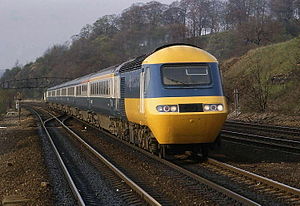InterCity 125

An InterCity 125 in original British Rail livery near Chesterfield
|
|||||||||
|
|||||||||
|
|||||||||
|
|||||||||
|
|||||||||
| Type and origin | |
|---|---|
| Power type | Diesel-electric |
| Build date | 1975–82 |
| Specifications | |
|---|---|
| UIC class | Bo'Bo' + 2'2' + ... + 2'2' + Bo'Bo' |
| Performance figures | |
|---|---|
| Maximum speed | 125 mph (201 km/h) (service) 148 mph (238 km/h) (record) |
| Power output | Engine: 2x 2,250 bhp (1,678 kW) |
| Tractive effort |
Maximum: 2x 17,980 lbf (80.0 kN) Continuous: 2x 10,340 lbf (46.0 kN) @64.5 mph (104 km/h) |
| Career | |
|---|---|
| Operators |
Current East Midlands Trains Grand Central CrossCountry Network Rail Virgin Trains East Coast Great Western Railway Future Abellio Scotrail |
| Disposition | in service |
InterCity 125 was the brand name of British Rail's diesel-powered High Speed Train (HST) fleet, which was built from 1975 to 1982 and was introduced in 1976. An InterCity 125 train is made up of two Class 43 power cars, one at each end of a fixed formation of Mark 3 carriages (the number of carriages varies by operator). The train operates at speeds of up to 125 mph (201 km/h) in regular service, and has an absolute maximum speed of 148 mph (238 km/h), making it the fastest diesel-powered train in the world, a record it has held from its introduction to the present day. Initially the sets were classified as Classes 253 and 254. A variant of the power cars operates in Australia as part of the XPT.
After four decades, most of the HST fleet is still in front-line revenue service under privatisation, and while the InterCity 125 brand name is rarely mentioned officially by the private train operating companies (TOCs), the InterCity 125 still forms the backbone of intercity services on several British main lines. Most sets are to be replaced on InterCity services by 2018 under the Intercity Express Programme. At first, that programme called for some HSTs to continue in use on London to Devon/Cornwall services where there are no plans to electrify the lines. However, in March 2015 it was announced that the remainder of the Great Western fleet would be replaced with bi-mode Intercity Express sets, equipped with the required powerplants and fuel tanks to tackle the distances and inclines of Westcountry services.
The trains currently operate from London Paddington to Penzance, Plymouth, Newquay (summer), Paignton, Exeter, Taunton, Westbury, Oxford, Cardiff, Swansea, Carmarthen, Pembroke Dock (summer), Bristol, Weston-super-Mare, Worcester, Great Malvern, Hereford and Cheltenham; from London St Pancras to Nottingham; from London King's Cross to Aberdeen, Inverness, Harrogate, Hull, Sunderland, Leeds, and Lincoln; on the CrossCountry route from Dundee, Glasgow, Edinburgh and Leeds to Plymouth (plus in summer to Paignton, Newquay and Penzance); from Derby to Skegness (summer only) and also Leeds to Aberdeen. One is in departmental use, as Network Rail's New Measurement Train, converted and in use since 2003.
...
Wikipedia
